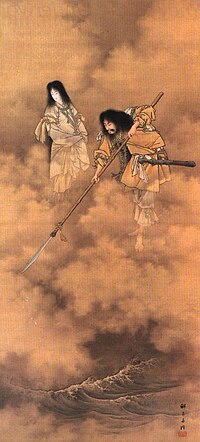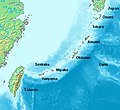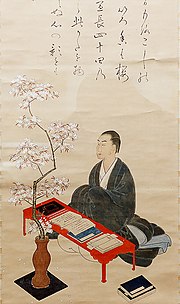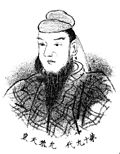 | Nihon Shoki (redirect from Nihonshoki) The Nihon Shoki (日本書紀), sometimes translated as The Chronicles of Japan, is the second-oldest book of classical Japanese history. The book is also called... 20 KB (2,124 words) - 07:22, 16 March 2024 |
 | Izanami (section In the Nihonshoki) in many aspects, the version of the tale of Izanagi and Izanami in the Nihonshoki differs from the Kojiki version in that Izanagi does not descend into... 14 KB (1,531 words) - 15:57, 22 April 2024 |
 | Kuninotokotachi-no-Kami, in Kojiki) (国常立尊, Kuninotokotachi-no-Mikoto, in Nihonshoki (no-Mikoto here being an honorific of divinity) or Kuni-toko-tachi is... 3 KB (300 words) - 13:25, 6 January 2024 |
Yamato". Buretsu is described as an extremely wicked historical figure. The Nihonshoki describes the 11-year-old Buretsu, in 500, cutting open the stomach of... 6 KB (600 words) - 00:38, 19 February 2024 |
(1986). "Patriarchal Revolution in Ancient Japan: Episodes from the "Nihonshoki" Sūjin Chronicle". Journal of Feminist Studies in Religion. 2 (2): 23–37... 72 KB (8,140 words) - 21:39, 29 April 2024 |
 | Yatagarasu is recorded in the Kojiki (Records of Ancient Matters), the Nihonshoki (Chronicles of Japan), and the Enki Shiki (Records of Ancient Matters)... 20 KB (1,806 words) - 13:49, 18 March 2024 |
 | is often broken to suit the poet's preferences. During the Kojiki and Nihonshoki periods the tanka retained a well defined form, but the history of the... 13 KB (1,578 words) - 20:05, 23 April 2024 |
 | state of Japan began to make contact with Tanegashima. According to the Nihonshoki, the imperial court hosted a banquet for the islanders of Tanegashima... 16 KB (1,434 words) - 21:53, 22 April 2024 |
 | Yung, and states that he restored Baekje into a strong nation. Japan's Nihonshoki gives his birthdate as 25 June 461, and describes him as the son of the... 7 KB (756 words) - 10:43, 25 April 2024 |
 | the Mahan confederacy. In 249, according to the ancient Japanese text Nihonshoki, Baekje's expansion reached the Gaya confederacy to its east, around the... 48 KB (5,291 words) - 10:32, 29 March 2024 |
 | unknown place in the Nihonshoki, a history book written in 720. There is no direct connection between the Hidaka of the Nihonshoki and the modern Hidaka... 7 KB (410 words) - 16:05, 12 April 2024 |
referred to as (ヤマト大王/大君) or the "Great King of Yamato". According to the Nihonshoki, he was of gentle personality and was in favor of Buddhism. In 645 he... 11 KB (1,151 words) - 00:48, 26 March 2024 |
 | year after the emperor's accession to the throne. The historical text Nihonshoki, written in the year 720, has the first mention of this ceremony, whose... 82 KB (9,720 words) - 07:32, 30 April 2024 |
over Ōomi , the Minister of State, from his father. According to the Nihonshoki, from the end of the reign of Empress Suiko to that of Empress Kōgyoku... 2 KB (227 words) - 07:01, 4 March 2024 |
 | whose construction Umako ordered, according to the Suiko section of the Nihonshoki. Ishibutai Kofun is believed to be the tomb of Soga no Umako. Soga no... 4 KB (319 words) - 04:35, 21 February 2024 |
sacred sword were moved to the current location of the Atsuta Shrine. Nihonshoki explains that this move occurred in the 51st year of Keiko's reign, but... 4 KB (1,457 words) - 02:28, 14 April 2024 |
Gen. Name according to Kojiki (Honorific form) Name according to Nihonshoki (Honorific form) 1 Kuninotokotachi (国之常立神, Kuninotokotachi-no-kami) Kuninotokotachi... 6 KB (259 words) - 11:34, 22 April 2024 |
 | bureaucrat, chronicler Known for Compiling the Kojiki Notable work Kojiki, Nihonshoki Title Junior Fourth Rank, Minbukyo (Junior Fourth Rank, Lower Grade),... 8 KB (552 words) - 16:24, 23 April 2024 |
brother, is likely to be an equivalent of Ankō, who is also noted in the Nihonshoki as an elder brother to Yūryaku. However, the Book of Song records Kō as... 21 KB (2,282 words) - 10:55, 27 December 2023 |











